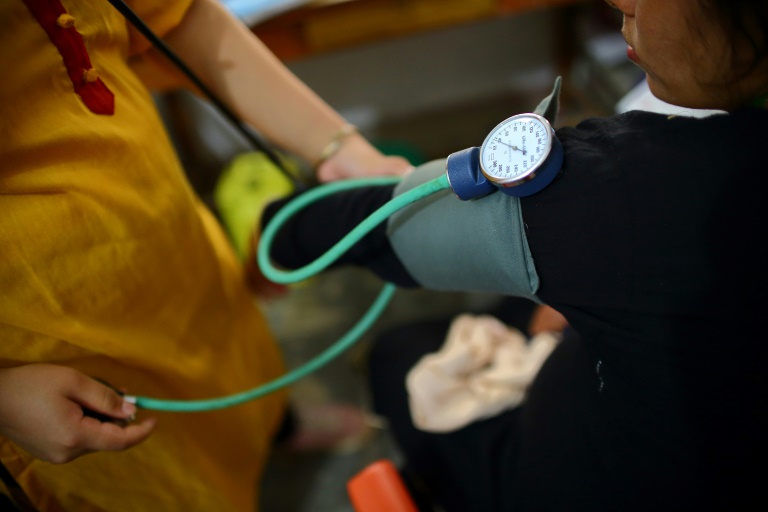Camille Abbey was two months away from giving birth to twins when she sensed something wasn’t right.
“I felt strange all week. I had swelled enormously. I had a lot of trouble moving,” said the 33-year-old French journalist.
Abbey’s midwife found her blood pressure spiking and sent her to hospital where doctors confirmed she had preeclampsia, a potentially life-threatening complication.
The risks of preeclampsia have been known about for centuries, but there is still no cure or prevention and a lack of awareness remains a problem.
“Although one in every 12 pregnancies are affected by preeclampsia, many pregnant women have never heard of the disease,” Patricia Maguire, director of the Institute for Discovery at University College Dublin, told AFP.
Doctors made a breakthrough 10 years ago that allowed them to develop the first diagnostic test, and Maguire is working on a second one, with trials under way in Ireland.
Early diagnosis is lifesaving because the condition sets in without symptoms.
Once they appear, the only way to stop complications like liver and kidney failure, or death, is to deliver the baby — even if it is premature.
A 2021 study showed that hypertensive disorders of pregnancy have increased in the last nearly 30 years, though better screening and population growth may account for the rise.
The study in the BMC Pregnancy and Childbirth journal also said that most deaths occur in low-income settings where doctors say the toll is likely higher than reported.
An estimated 76,000 women and 500,000 babies die every year due to hypertensive pregnancy conditions like preeclampsia and eclampsia, a rare complication, according to a 2015 study in the Journal of Family Medicine and Primary Care.
Sarah Kilpatrick, an obstetrician-gynecologist specialising in preeclampsia at Cedars-Sinai hospital in Los Angeles, says educating women is crucial.
“The hard part for women is many times they feel fine,” Kilpatrick told AFP, “so you can’t even believe you have something like preeclampsia.”
– Like ‘lightning’ –
Emmanuelle Honore survived eclampsia — named after the Greek word for lightning — which can develop if preeclampsia goes undetected and lead to potentially fatal seizures.
Her decision to walk herself to hospital after monitoring her own blood pressure saved her life.
“They didn’t wait for the blood test results to come back to decide to do an emergency cesarean,” said the Paris-based archaeologist, 37.
Immediately after giving birth, she began to convulse.
“It was a question of minutes. The baby and I were incredibly lucky,” she told AFP. “During the seizure I felt myself leaving my own body.”
Today, her son is healthy and turns three in February.
But the eclampsia has left Honore psychologically scarred and unable to give birth again.
“For me, there is a before and an after — it’s two different lives.”
– ‘Dream of reaching everyone’ –
The world’s first diagnostic test, developed by kidney specialists Ananth Karumanchi and Ravi Thadhani by linking the levels of two proteins to the disorder’s onset, has been available in Europe for a decade.
It is in clinical trials in the United States, where preeclampsia disproportionately affects Black women due to a higher prevalence of risk factors like diabetes, obesity and stress, the American Heart Association says.
“(The trials) include the diversity of women in the United States and by the end of this year we will be able to determine whether the diagnostics have just as much benefit and specificity as in Europe,” Thadhani told AFP.
The test developed by Maguire not only detects preeclampsia with a blood sample, it uses artificial intelligence to provide a timeframe for safe delivery, allowing as much time as possible for the foetus to develop.
An article published in May said the test had the potential to be streamlined so that kits could be sent to hospitals with easy-to-collect samples analysed using online information.
“The big dream is to reach every person who needs this test across the world,” Maguire said.
– Lifelong consequences –
Even after labour, preeclampsia sufferers are not necessarily out of danger.
Kilpatrick said about one in 10 women whose preeclampsia was their first time with high blood pressure need to stay on anti-hypertensive medication after giving birth.
When her twins were born in October 2020, Abbey thought her ordeal was over but her blood pressure failed to go back to normal.
She was later diagnosed with the dangerous preeclampsia-related condition HELLP (Hemolysis, Elevated Liver enzymes and Low Platelets) syndrome, which affects some 15 percent of women with severe preeclampsia.
While her premature babies received state-of-the-art care, Abbey said she stayed in a post-op recovery room for days where doctors could do little more than monitor her vital signs and try to control her blood pressure.
Vassilis Tsatsaris, an obstetrician-gynecologist at Paris’ Port Royal hospital, said research on finding treatments for preeclampsia and other complications has been impeded by the risks for the unborn baby.
“We live in an era where therapeutic innovations for cancer, vaccines or gene therapy are advancing very, very quickly,” he told AFP.
“Unfortunately when it comes to pregnancy, things move much more slowly.”









